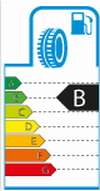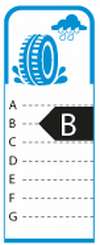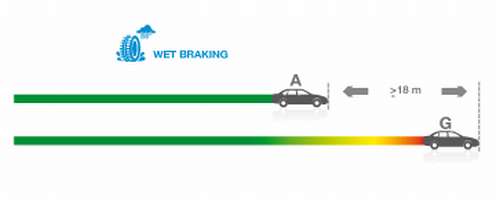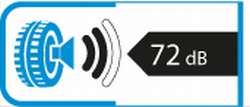The new EU mandatory labeling system for tires. Cars only, not bikes!
The new EU mandatory labeling system for tires provides significant information concerning the tire specifications with respect to safety and environment. Its like domestic appliances, the EU labeling makes it easier for the customer to compare different products, tires in terms of traction on the wet, fuel efficiency and noise.
Fuel consumption


Did you know that tires spend up to 20% of the fuel consumption of a car? Selecting high efficiency fuel consumption tires, tank range will be increased, the air pollutants will decrease.
Fuel efficiency is distinguished from Ń to G, there is a corresponding color variation.
A (green) = the highest efficiency factor
G (red) = the lowest efficiency factor concerning fuel consumption.
What do these factors mean
The difference between factor A and G could result to a fuel consumption reduction up to 7.5%. On real life measurements, choosing tires rated A instead of tires rated G, a driver could save more than 6 l/1000 km (4.5 mpg Imperial).
Braking



The tire braking ability on the wet is a significant factor when selecting new tires. The tires graded higher on the wet stop sooner under emergency braking.
The EU labeling system focuses only in braking on wet, there are more factors playing a role and determining road handling on the wet.
Handling on the wet is graded from Ń to F:
A = higher factor
F = lower factor
What do these factors mean?
In a typical emergency braking, its only a few meters of braking distance which can make a big difference. Concerning a car, under extreme braking form the speed of 80 km/h (50 mph), a tire set rated A will require a braking distance less than 18 meters (59 ft) from a set of tires rated F.
Noise



‘ires contribute to the noise produced by a vehicle. Selecting tires featuring low sound factor, the noise of our vehicle is decreased.
The EU noise level scale measures the noise produced by the tire in Decibels.
Noise scale.
Since many people are not familiar with the decibel scale, an image has been introduced, rating tires according to the EU legislation.
• 1 black wave: Noiseless (3dB or greater, less than the future EU limit)
• 2 black waves: Average (between the future EU limit and 3dB less than that)
• 3 black waves: Noisy (above the future EU limit)
Note: A difference to the level of noise by just 3dB means double the noise of the tire.

Comments: Motorcycle engines are not insulated in terms of noise suppression like car engines. Thus tire noise is not really important. However these guidelines can be very helpful concerning braking distance on the wet, actually itĘs a crucial road safety issue for every biker. This would also provide a hint for dry, yet low friction factor roads, on normal bike tires. Thus this labeling system is not just another gimmick, it should apply to bike tires also.


